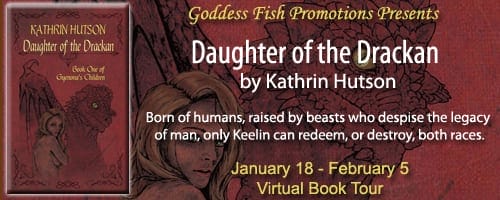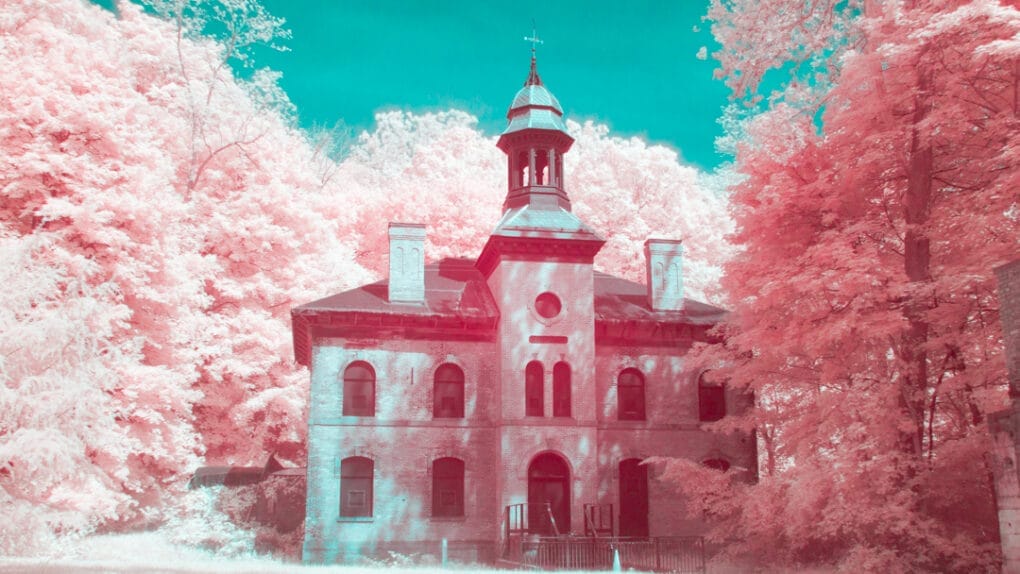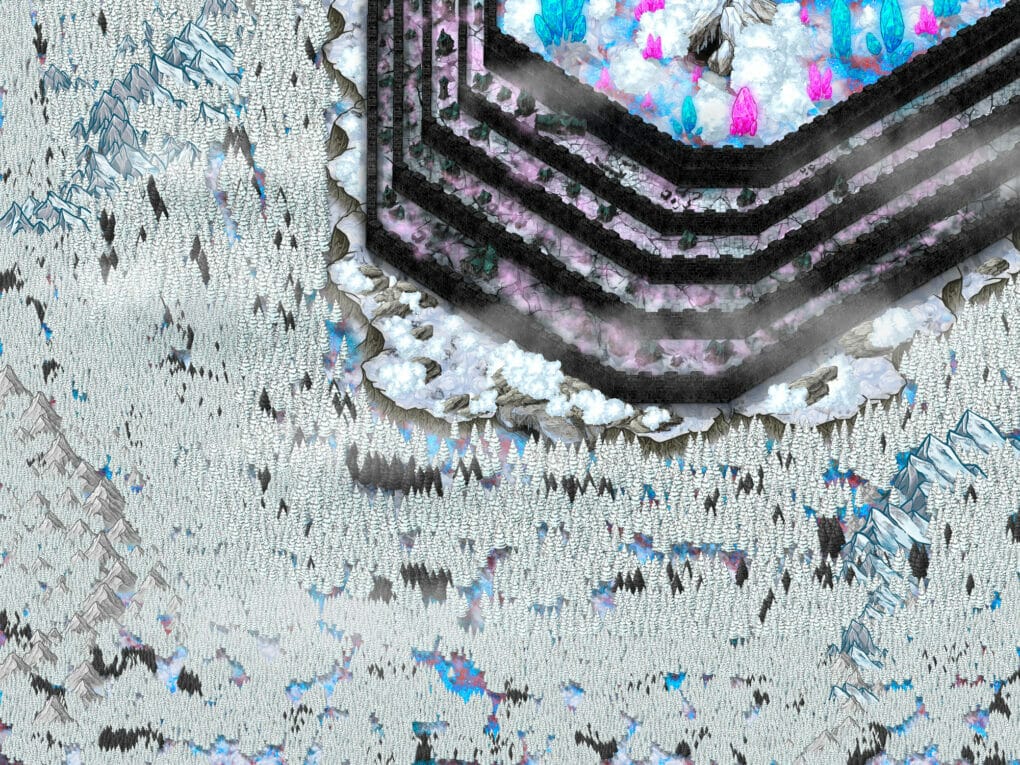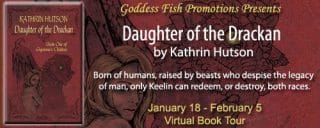
Kathrin Hutson will be awarding a $25 Amazon/BN GC to a randomly drawn winner. Enter via rafflecopter at the bottom of the post.
As writers, it’s challenging not to get caught up in all the intricate details of our worlds, wanting to share every little morsel we can with our readers. As readers, we want to feel like we’ve been transported into this world and can trek its hills and valleys as if they were our own.
Tread carefully, creators of the realm. For it is a slippery slope when distracting your adventurers by shoving a list of terms, definitions, and appendices in their faces.
Those here for the magic wish to experience it for themselves.
As a fantasy author, it’s important to build a sturdy wall between the immensity of your Fantasy universe and what you allow your readers to see. Think about Pointillism Art. Millions of tiny, detailed dots of paint, all put together in such a way to create an entire scene. Give too much attention to any individual dot or small grouping, and you lose the beauty of the painting.
Here are some tools for you to use when building your supreme Fantasy masterpiece, and the difference when adding them to the actual written work of your novel.
Building a Fantasy World
- Maps—If your protagonist embarks on his or her epic quest in a fairly large realm, they inevitably will travel a lot. I do recommend mapping out your world. Villages, towns, rivers, mountain ranges. Destinations. It keeps you on track with directions, too, which I find difficult without a visual. Trust me, you don’t want to say “they continued east” half the time, and the other half, “they continued west”. You don’t need anything fancy, nor do you want to spend so much time on the minute details that you don’t write. I mapped the world for the ‘Gyenona’s Children’ series, but it was merely scribbles. If you lack inspiration for maps, I think something like Donjon’s random world generator is pretty cool http://donjon.bin.sh/fantasy/world/. And free.
- Creature/tribe/race sketches—Your hero’s journey may take them into different tribes whose culture they must learn, battling fearsome creatures, or rescuing the helpless ones. For races and cultures of people, outline what they wear, their values, how they sustain themselves, the layout of their villages. Creatures can be defined by their strengths and weakness, size, lifespan, and/or usefulness. You don’t need to be a good artist for any of these (though if you are, awesome!). I like scrolling through Google images for anything even remotely related to what I’m adding to the story. Sometimes, even just looking at the images ingrains them in your mind.
- Lore and Legend—Not all worlds need this, but sometimes they play a huge role in the story line. If you feel one begging to be created, try a simple, chronological outline. It goes quickly, and it’s a great reference to look back on.
Writing the World
- Location—It’s just not necessary to name every city or geographical landmark on your world map. It distracts from the story and makes it difficult to follow. Choose the places essential to your hero’s journey. Describe their destinations or pit-stops, and be careful to avoid the full backstory of even those places. Readers want to see the place, know its name, get a feel for it, and move on. Dropping a location name here and there (even without further detail) definitely adds to the breadth of the world.
- Creatures/tribes/races—These are tricky, and my favorite method is to describe these in the narrative as though you, your character, and the reader already knows what they are. For example: “He recognized the caramel-colored skin, the flecks of red in the eyes, and hoped the warrior tribe would not think his words a threat to their livelihood.” Here, you get a physical description, that the people are warlike, that they fight to survive, and that they are easily offended. In my opinion, if you can sum up anything in one sentence, all the better.
- Lore and Legend—I personally do not like reading, “As the Legend of the Gahecian Savior went…” followed by three pages of the actual legend. Not only does it take the reader out of the protagonist’s story (which is the best part), it feels like a textbook. A great tool for incorporating these is to deliver them in snippets. Summarize it in one sentence. Then, later, your hero overhears someone talk about it and gets more information. Then their ‘guide’ or ‘trainer’ explains it a bit further. Leave a trail of breadcrumbs. Readers will get the information when your hero does, and that adds for intrigue, curiosity, and suspense.
Of course, every story and world is different, as is every author. These are general guidelines I try to follow in my own work, and I hope at the very least they’ve sparked some inspiration (and maybe made things easier).
Thank you so much, Dark Treasury, for hosting this stop on your site today. I’m thrilled to be here and so grateful for the opportunity. –Kathrin

 Kathrin Hutson has been writing fiction for fifteen years, editing for five, and plunging in and out of reality since she first became aware of the concept. Kathrin specializes in Dark Fantasy and Sci-fi, and the second novel in this series, Mother of the Drackan, will be released this February.
Kathrin Hutson has been writing fiction for fifteen years, editing for five, and plunging in and out of reality since she first became aware of the concept. Kathrin specializes in Dark Fantasy and Sci-fi, and the second novel in this series, Mother of the Drackan, will be released this February.
Kathrin runs her own independent editing company, KLH CreateWorks, for Indie Authors of all genres. She also serves as Story Coordinator and Chief Editor for Collaborative Writing Challenge, and Editing Director for Rambunctious Rambling Publications, Inc. Needless to say, she doesn’t have time to do anything she doesn’t enjoy.
You can grab your copy of Daughter of the Drackan, in print or as an ebook, on Amazon here: mybook.to/daughterdrackan

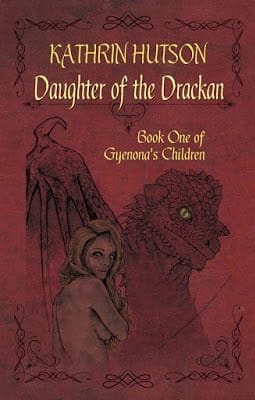
Keelin is the only human fledgling, weaned by the drackans of the High Hills and given their instincts, ferocious strength, and fierce hatred for humankind. But even the drackans closest to her cannot explain why she has violent blackouts from which she wakens covered in blood.
A desperate, reckless search for the source of this secret brings her face to face with the human world and memories from a locked-away past, long forgotten. Keelin becomes a terrifying legend among human assassins while she hunts for answers, and the human realm’s High King is murdered.
While a sickly steward hides within crumbling walls, commanding her every move with a magic he should not possess, Keelin’s journey to track him down threatens her loyalty to the drackans who raised her. The rogue who crosses her path hides familiar secrets, echoing her own terrifying bloodlust and forcing her to consider that there may be something human about her, after all.

The others snorted and growled at the human, their hatred and bloodlust already thick in the air. The drackans’ centuries-old feud with the scale-less race ran deep within their blood. Seeing one now in their home stirred timeless memories of the war, so long ago, that had started their hatred in the first place, and memories of the last human fledgling who had turned astray.
Igetheyr shifted his eyes toward the child, expressionless until he chose to speak. E’Kahlyn shot her mind-voice in a direct, shielded stream to the child, hoping to reach it before Igetheyr did. ‘Have you heard our discussion?’
A light, purple-gray blotch found its way slowly to her mind with the feeble words, ‘I did.’
‘Then go to him, young one.’
The child slid to the ground, gazing at the drackan with pleading eyes. E’Kahlyn nudged her forward with her snout. The child stumbled toward Igetheyr’s great figure and placed her hands behind her back. Her narrow chest stuck out vulnerably, head held high, and she met eyes with the black drackan. Fear did not exist in the child, as if it never had. She was part of the new world around her now and still so disconnected.
Igetheyr snorted, seemingly entrapped by her boldness. E’Kahlyn opened her mind to just the two of them, eagerly awaiting the important exchange, the final word.

Kathrin Hutson will be awarding a $25 Amazon/BN GC to a randomly drawn winner via rafflecopter during the tour.

